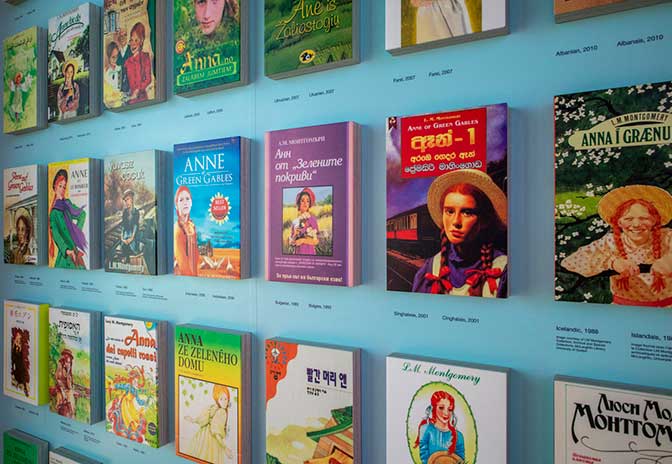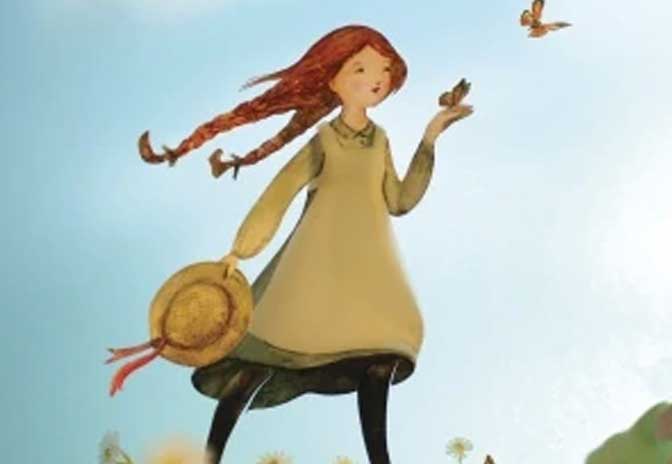Anne at Centre Stage
Anne at Centre Stage: Anne of Green Gables—The Musical™
Fraser McCallum
The idea to adapt L.M. Montgomery’s Anne of Green Gables into the (now famous) musical form was born out of a brief visit between Canadian humourist, actor, and writer Don Harron and his friends, musician-writers Norman and Elaine Campbell. The Campbells gifted Harron a copy of the famed novel while the veteran performer was sick with the flu, and it soon lit a spark within him.
Elaine and Norman Campbell discuss the origins of the musical. (01:16)

Royal Command
The legendary Canadian team of Harron and the Campbells first adapted Anne of Green Gables for a CBC TV special in 1956. In 1964, the team was invited to Charlottetown by Mavor Moore, the artistic director of the new Confederation Centre of the Arts, Canada’s national memorial to the country’s founding. Moore was directing a grand variety performance for the official opening of Confederation Centre and its state-of-the-art 1,100-seat Mainstage Theatre, and he invited the pair to present a short vignette derived from their earlier Anne of Green Gables television adaptation.
Her Royal Majesty Queen Elizabeth II was in attendance to officially open the Centre, and legend has it she "was amused" upon seeing Harron and Campbell’s Anne vignette and asked about the rest of the story. Campbell, Harron, and Moore considered her feedback as "the Royal Command" and set about expanding their work into a complete two-act musical for the following summer in Charlottetown.

The cover of the 1969 program for the musical, the star feature of "The Charlottetown Festival."
The Charlottetown Festival
As the Centre’s first artistic director, Moore was tasked with developing a new summer festival of musical theatre for the Island. The vision was an annual, professional-level festival of "music and laughter," one that reflected Canadian culture and identity to Islanders and visitors alike. Moore knew that Anne Shirley was the best-known character in Canadian literature, and the perfect subject matter for both a new Canadian musical and a Prince Edward Island-based festival.
Moore also saw Montgomery’s work as an honest representation of the Island character, “… one that causes us to rejoice in our own triumphs and weep at our own sorrows as we see them mirrored in her Avonlea,” he shared in an early interview. “It is this very combination of qualities—rejoicing and sorrowing, and the recognition of both, which makes Anne … such apt source material for the musical comedy form,” he posited.
“… an orphan girl’s quest; but Anne Shirley is a classic portrait—and a portrait can come to life on the stage with even greater vitality than it can on the printed page.”
The Musical Comes to Life
By the summer of 1965, Harron had completed the musical’s book (dialogue, stage directions, etc.), and the Campbells had composed the undeniably catchy music, including such now-iconic songs as “Ice Cream,” “Gee I’m Glad I’m No One Else But Me,” and “The Apology.” All three are credited for the songs’ lyrics, with contributions from Moore. The world premiere of Anne of Green Gables—The Musical™ took place in the Mainstage Theatre on July 27, 1965—a momentous occasion for the cast, creative team, and Island community.
The original creative team was complimented by Costume Designer Marie Day, Set Designer Murray Laufer, and Original Director and Choreographer Alan Lund (who would succeed Moore as the next artistic director in 1966). The 1965 original cast starred Barbara Hamilton and Peter Mews as Marilla and Matthew Cuthbert, Maud Whitmore as Rachel Lynde, and young Jamie Ray (originally from Texas) as Anne Shirley.

Jamie Ray, who played Anne from 1965-1969.
Ray would play the title role for its first three festival seasons and is remembered fondly by her successor, P.E.I.’s own Gracie Finley: “Jamie was as warm and giving off stage as she was onstage, and when I joined the company as a young apprentice, I shall never forget her welcome support and advice, and the warmth in her lovely soft Texan voice.” Finley still holds the record for the longest-tenured Anne, donning the red braids from 1968 to 1974, and then again from 1984-85. Eighteen more women have stepped into the title role, including fellow Islander Jessica Gallant (2015-16) and most recently, Kelsey Verzotti (2022).
“All we Annes who have followed in Jamie’s footsteps inherited a role lovingly crafted and portrayed,” recalls Finley. “She was the pioneer, the one who took Anne from the pages of the script to the lights of the stage, and we owe her a great deal for her work and inspiration. She was a true lady, and also our First Anne.”

The cover of the booklet for the Charlottetown Festival's 20th anniversary season, where Gracie Finlay reprised her role as Anne.
Anne Endures
The Island’s now-famed musical has toured outside of Confederation Centre numerous times, including a tour to major Canadian cities in 1967 and to the World’s Fair in Osaka, Japan in 1970, representing Canada. In 1969, Anne played on London’s West End, winning the Drama Critics Award for Best New Musical. Other touring appearances include a brief appearance Off-Broadway from December 21, 1971 to January 2, 1972; Expo ‘86 (Vancouver); a Japanese tour to eight cities; and various Canadian national tours and limited runs in Toronto, Connecticut, and other places.


The casts of the musical from 1965 and 2011.
The musical’s staying power can be partially attributed to the original source, of course; however, critics in major markets lauded the show for its own merits, dubbing it “the major family musical at its best” (London Times) and “the most wholesome musical since The Sound of Music” (Daily Express). Perhaps Reuters was most apt in 1974: “Anne wins 10 curtain calls … a refreshing breeze of charm and sentiment.” Neither Montgomery nor the musical’s original creative team ever let the sweet side of the story override Anne’s gusto, determination, and sense of humour.

The cover of the Anne of Green Gables—The Musical™ album
The show’s official cast recording has now sold approximately 50,000 copies and Anne of Green Gables—The Musical™ has been seen by an estimated 2.5 million people. In 2014, Anne achieved a Guinness World Record as "the world’s longest-running annual musical" and in 2017, the production marked its 2,500th presentation by The Charlottetown Festival.
“Anne of Green Gables, never change, we like you just this way…”
An excerpt of Feelin' Mighty Proud, a broadcast special celebrating Anne of Green Gables—The Musical™ (2:52)
and the legacy of Anne Shirley, which aired in the fall of 2020.






